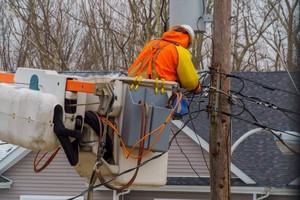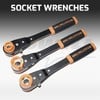Have you ever wondered how linemen work on high-power transmission lines and keep our contemporary wired world working? It isn’t easy to maintain and repair telecommunications lines and cable lines. Highline work involves a complex process and immense hard work of the dedicated people working on it.
Let’s discover what it takes for linemen to keep the American electrical grid working.
What We’ll Cover:
- What does highline work look like?
- Lineman wrenches
- Clamps
- Clusters
- Wire ferrules
- Scaffolds
- Hardhats
- Boots
- Insulated gloves
- Climbing belts
- Faraday cage suits
- How linemen repair power lines
- Key takeaways
What Does Highline Work Look Like?
Linemen are responsible for maintaining power transmission, distribution, and telecommunication lines. They ensure the end-users are facilitated by electricity and network supply in homes, offices, industries, and hospitals.
Moreover, they are also involved in fixing and maintaining the cable television lines and fiber optic lines. The process of highlines might also involve distributing transformers on poles, insulators, and fuses. They work on both live wires and dead wires.
The process involves physical exertion in inaccessible areas where you use manual tools. The process might involve ropes, knots, and lifting equipment. Linemen may use a pair of spikes and climb the wooden ladders or poles to gain access to the high wires.
However, linemen who must cover a considerable distance to high-tension power lines use helicopters. This process is complicated since it should be made sure that the linemen are isolated from the ground. The linemen also wear unique protective and conductive costumes while handling the wire.
What Tools and Equipment Should I Use for Highline Work?
The linemen working on highlines need to service transmission and distribution lines. They might also have to work on live wires and rugged terrains.
Thus, they need many tools and equipment to handle their operation—these tools and equipment help them easily perform their tasks.
Here are some of the highline and utility tools mentioned below which are handy while linemen are on their duty:
Lineman WrenchesA lineman wrench is required for high-line pole installation and repair. It helps in tight ratcheting mechanisms. The long handle of the wrenches also ensures greater leverage. Some socket wrenches come with bolt-through designs that enable use on long bolts. It also provides you with a smooth surface for hammering.
Linemen or “spud wrenches” are essential tools for utility workers who perform maintenance and repair on power lines, transmission towers, and other electrical infrastructure. These wrenches are designed to fit over the bolts and nuts that secure heavy-duty electrical components in place, allowing workers to tighten or loosen them as needed quickly.
With their adjustable jaws, these wrenches can tackle a wide range of bolt sizes and configurations, making them a go-to tool for utility workers who never know exactly what kind of hardware they need on any given job. The durable, heavy-duty construction of these wrenches also ensures they can withstand the harsh conditions and heavy loads that utility workers encounter daily.
ClampsWire clamps, also known as cable grips or wire grips, are essential tools for utility workers who work with electrical cables and wires. These clamps are designed to securely grip the cable or wire, preventing it from slipping or moving during installation or maintenance. They are typically made from high-strength materials such as steel or aluminum and are available in various sizes to accommodate different cable or wire diameters.
One of the key benefits of wire clamps is that they help to improve electrical safety for utility workers. When working with live electrical cables or wires, it’s essential to ensure they are securely anchored to prevent the risk of electrical shock or other hazards. Wire clamps provide a secure anchor point, reducing the risk of the cable or wire coming loose and causing an accident.
Wire clamps can also help to improve efficiency and productivity for utility workers. By securely holding the cable or wire in place, workers can perform their tasks more quickly and accurately without worrying about the cable or wire moving or shifting during installation or maintenance. This can help to reduce the time and effort required for each task, allowing workers to complete more work in less time and with greater confidence and safety.
Clusters
Clusters, also known as four-way connectors, are essential tools for utility workers who need to splice or connect multiple cables or wires. These connectors typically consist of a central body with four or more arms, each of which can be connected to a separate cable or wire. They are available in various sizes and materials to accommodate different cable or wire diameters and types.
In electrical work, clusters provide a secure and reliable method for splicing or connecting multiple cables or wires. By securely connecting each cable or wire to the central body of the cluster, workers can create a strong and stable connection that is less likely to come loose or fail over time. This can be especially important in applications where the cables or wires are exposed to environmental stressors, such as vibration or extreme temperatures.
Another benefit of clusters is that they help simplify the process of splicing or connecting multiple cables or wires. Instead of splicing or connecting each cable or wire individually, workers can use a single cluster to connect multiple cables or wires at once. This can help to save time and effort and can also help to reduce the risk of errors or mistakes during the splicing or connection process.
Wire FerrulesWire ferrules, also known as cord end terminals or wire end sleeves, are small metal or plastic sleeves crimped onto a wire’s end. They provide a neat and secure connection between the wire, terminal block, or another connection point. Wire ferrules are available in various sizes and materials and can be used with various types of wire.
Wire ferrules help linemen improve the reliability and safety of electrical connections. By providing a secure and stable connection between the wire and the terminal block or other connection points, wire ferrules help to prevent the wire from becoming loose or disconnected over time. This can be especially important in applications where vibration or other environmental factors may cause wires to become loose or disconnected.
Overall, wire ferrules can help to simplify the process of making electrical connections. By crimping a ferrule onto the end of a wire, workers can create a neat and uniform connection that is easy to insert into a terminal block or other connection points. This can help to save time and effort during installation or maintenance and can also help to reduce the risk of errors or mistakes during the connection process.
ScaffoldsScaffolds are temporary structures that provide a stable and secure platform for workers to perform their jobs at heights. They are typically made from metal or wood and designed to be assembled and easily disassembled. Scaffolds come in various sizes and configurations to accommodate different types of work and can be customized to fit specific job requirements.
Furthermore, scaffolds are that they provide a safe and stable platform for workers to perform their jobs at heights. This is especially important for utility workers who perform maintenance or installation tasks on poles, towers, or other elevated structures. Scaffolds provide a secure and stable working platform that allows workers to focus on their tasks without worrying about safety.
The best application of scaffolds is that they can be easily moved or repositioned. This can be especially important in applications where workers must move from one location to another, such as when installing or repairing power lines or communication cables. Scaffolds can be quickly and easily disassembled and moved to a new location, providing workers with a stable and secure platform to work from.












